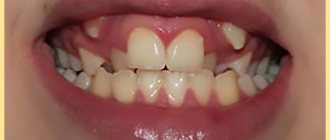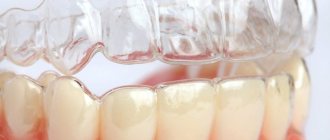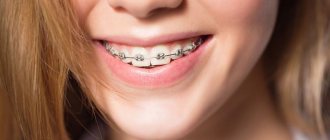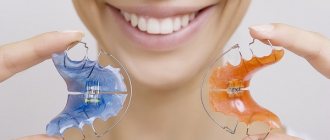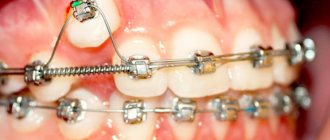Why do teeth hurt with braces? The fact is that during orthodontic treatment, a targeted physical effect is applied to the dental system, changing its usual state. The traction of the orthodontic arch causes irritation of the nerve endings, and the body’s response becomes unpleasant and sometimes very painful sensations. The degree of their severity depends on a number of factors - age, gender, clinical situation and individual reaction to stress. Therefore, doctors cannot offer a universal remedy to relieve patients of discomfort, but, of course, it is possible to alleviate the unpleasant sensations that arise at different stages of correction.
Does it hurt to get braces?
Depending on the chosen method of fixing the locks on the teeth, the procedure lasts up to 2–3 hours. It is not accompanied by painful sensations; the patient may experience some discomfort only from prolonged sitting in a chair.
But do not forget that before installing braces, the oral cavity is sanitized. It includes treatment of tooth decay and gum disease, as well as professional teeth cleaning to remove soft deposits and tartar. In some cases, in order to securely fix the braces, it is necessary to lightly process the tooth enamel. When performing the corresponding manipulations, painful sensations may occur, from which the patient is relieved by safe local anesthesia.
When should I expect pain to appear?
Before you decide to create a beautiful and attractive smile with the help of braces, you should learn more about this technology. It is carried out in stages.
- First of all, preparatory work is carried out. They include the treatment of dental caries and the removal of plaque from their surface. This is done in order to eliminate all problems associated with the integrity of tooth enamel and minimize the risks of gum disease. After all, braces are installed for a very long period, which can even be several years.
- Next, the bracket system is customized for each person individually, based on the shape and size of their jaws.
- The treating dentist fixes the breaker element on each tooth using special glue, after which all their clasps are connected to the arches of the bracket system. In this case, no pain should occur, since the work is carried out only on the surface of the teeth. Of course, the patient feels some discomfort due to a foreign object appearing in the mouth.
It should also be understood that the presence of a braces system in the oral cavity, attached to the teeth, requires special hygiene procedures and rules for eating, as well as following a certain diet. This is especially true for the most common version of braces – a permanent structure.
The work of the braces system consists of targeted pressure on a number of teeth through special arches. The strength and direction of this impact is adjusted by the doctor, using special screws, rubber rods or wire arches, depending on the design features of the braces. It is for this reason that teeth hurt when wearing braces for the first time after installation or a session of correcting their position.
Painful sensations in most cases directly depend on the force of pressure of the braces on the teeth. A highly qualified specialist with successful experience very accurately calculates the level of force so that the teeth are moved not only effectively, but also as painlessly as possible.
But even the most experienced doctor can cause pain with his actions. This happens when a person has a very low pain threshold. The patient must immediately inform his dentist about this. Based on this statement, the treatment schedule will be revised, the pressure of the adjustment screws will be reduced, and certain pain medications will be prescribed to reduce the pain from braces.
The patient often experiences pain after replacing the arches, but, as practice shows, it is quite mild and goes away quickly. Otherwise, you should immediately contact your doctor to resolve this problem.
How long do your teeth hurt after getting braces?
If your teeth or gums start to hurt after you got braces, don’t worry too much. Surely your doctor warned you that there may be pain at first.
Such unpleasant and painful sensations immediately after the installation of these orthodontic structures is completed is a completely natural phenomenon. Depending on the individual characteristics of the body, pain can be of varying degrees; there were practically no cases when the patient was able to avoid it.
Most importantly, you should not immediately blame the attending physician for the appearance of pain and discomfort, claiming that he installed the braces incorrectly and worked negligently. This is absolutely not true.
- First, each person has a different perception of pain and a certain level of patience to ignore it for a while.
- Secondly, it is easier to endure pain when you understand what caused it. To straighten the dentition, a certain amount of pressure is applied to each tooth. This, in turn, causes loosening of the row element with subsequent build-up of bone tissue. This whole process causes not only severe discomfort, but also quite severe pain. This adjustment period can last from several days to one or two weeks.
To minimize your suffering, you should visit your dentist so that he can prescribe the most effective painkillers for you.
After a certain time after taking these medications, the pain goes away, and the teeth, accustomed to the stress of the braces system, will not cause any discomfort in the future.
Recommendations on how to relieve pain from braces
To make the feeling of discomfort and pain due to such a foreign structure in the oral cavity as a brace system go away faster and easier, you should pay attention to the following tips:
- If severe pain occurs during the first time after installing braces, you should take painkillers strictly as prescribed by your doctor. As a rule, medications are taken after meals.
- If the design of the brace system irritates the oral mucosa, it is recommended to stick orthodontic wax on its surface. After three to four days, after you have gotten used to the braces, you don’t have to use wax.
- You can get rid of pain quite successfully by simply rinsing your mouth with salted water or other similar solutions. It is advisable to carry out this procedure several times throughout the day.
- If damage to the mucous membrane has occurred and a wound has formed on the oral cavity, then it is necessary to immediately apply medications that promote wound healing and relieve pain.
After installing braces, you should pay close attention to the range of products that are included in your daily diet. You should definitely avoid chewing gum and seeds, fresh carrots and green apples, hard cheese and sausages, as well as other products that can clog and clog the space between the tooth enamel and the brace system structure.
It would be optimal to stick to a diet with light first courses, various cereals, steamed vegetables and meat while wearing braces. Today you can find many delicious dishes, the recipes of which are perfect for people with installed braces.
Why do my teeth hurt after getting braces?
Discomfort is caused by two reasons.
- The orthodontic arch puts a lot of pressure on the teeth. When changing position, they, in turn, affect the ligaments, causing them to compress on one side and stretch on the other, and on bone tissue. When developing a treatment program, the orthodontist tries to calculate the traction force of the arch so that the correction is effective and the pain is tolerable.
- During the adjustment period, protruding elements of the braces system can injure the mucous membranes of the cheeks, tongue and lips. The patient will be given orthodontic wax and given instructions on its use. Applied to problem areas, wax will protect the mucous membranes from chafing and irritation, significantly reducing discomfort.
What does pain mean?
Any pain while wearing braces indicates that pressure is being placed on the teeth. The process of bite correction involves not only soft tissue, but also bone tissue. It is changes in bone tissue that lead to unpleasant sensations, while soft tissues easily adapt to their new position.
It is important to know that there is nothing dangerous about this pain. This does not indicate destructive processes or inflammation, it only confirms the fact that the pathology has begun to be corrected.
There are a large number of nerve endings in the oral cavity, so it is almost impossible to completely get rid of discomfort. It can be made less pronounced with medication or rinsing.
If small ulcers or wounds appear on the inner surface of the cheeks, tongue or lips, this may be the result of constant friction against metal elements. Such wounds and cuts go away quickly enough and without additional intervention. Experts recommend using orthodontic wax or silicone, this will help remove unpleasant symptoms.
Why do my teeth hurt from braces after activating treatment?
Painful sensations return for several days when the system is activated. After a certain time, the teeth are aligned, the bite is corrected, the ligatures are stretched, and the force of the arc decreases. To restore the effectiveness of ligature braces, the doctor periodically corrects them:
- after 3–4 weeks, renews ligatures;
- after 2–3 months, replaces the arch;
- At each appointment, checks the secure fastening of the locks.
Self-ligating systems need to be activated less frequently. The severity of pain depends on the individual pain threshold and the condition of the dental system. Typically, teeth respond to the next increase in traction within 2–3 days.
When to see a dentist
To effectively straighten your teeth, you should regularly tighten your braces. You must visit the doctor every month. In difficult cases, this is done every 2 weeks. Self-ligating braces allow you to visit the dentist once every 2 months.
To get a beautiful smile, you need to follow all recommendations and visit dentists at every opportunity.
If you have not yet chosen your braces system, contact our dentists.
We have qualified orthopedists and the most attractive prices for braces. Sapphire braces, metal braces, non-ligature braces and many others - you can discuss each option with your doctor, choosing the best one! The doctor's consultation
Why do my teeth hurt after braces are removed?
The procedure for removing the system is painless. After removing the archwire, the attending physician, using a special tool, removes the clasps and polishes the enamel to remove any remnants of the fixing compound.
In some patients, the enamel may become especially sensitive after wearing braces. It will react to hot and cold drinks and foods, salty and sour foods, etc. To prevent the appearance of hypersensitivity, it is restored with the help of special gels, varnishes and toothpastes.
After the braces are removed, the teeth that are lined up in an even row will try to return to their previous position. This may also cause pain. To maintain the results of treatment, patients have to wear a so-called retainer. A non-removable plate attached to the inside of the teeth or a transparent removable mouthguard will hold the teeth in the desired position, secure the result of the correction and relieve discomfort.
Pain when wearing braces that is not normal
Above we described discomfort with braces, which is normal. But some painful sensations indicate inflammatory or pathological processes.
The fact is that orthodontic treatment is a serious test for the body. The entire dental system is being rebuilt and requires special monitoring and care.
What sensations may indicate the presence of dental diseases:
- Aching and sharp pain in individual teeth
can be caused by caries or inflammation of the canals. - Pain in the area of contact between the gums and teeth
as a result of recession - loss of gums. Recession often accompanies orthodontic treatment, as the roots of the teeth move and put pressure on the periodontal tissue, which can cause gradual gum resorption. - Pain in the temporomandibular joint.
Some patients are predisposed to TMJ dysfunction - the joint can move into a new position during orthodontic treatment and cause discomfort and discomfort. You must report them to the orthodontist - the doctor will take the necessary measures. - Enamel sensitivity
. Braces make hygiene difficult and can weaken tooth enamel. If the enamel is excessively sensitive, you should definitely visit a therapist or hygienist. A specialist will clean and remineralize your teeth.
To prevent the development of inflammation, undergo professional hygiene and a preventive examination with a therapist at least once every six months. Report any strange or sharp sensations in your teeth, gums and joints to your orthodontist.
How to relieve toothache from braces?
- Take the pain reliever at the dosage prescribed by your doctor and at the recommended frequency.
- Use local anesthetics - gels and mouthwashes that dull the pain for a couple of hours.
- Baths with warm salt water soothe pain and heal abrasions of the soft tissues of the oral cavity. The solution should be kept in the mouth for about a minute, and the procedure should be repeated several times a day.
- Relieve inflammation by rinsing or bathing with 3% hydrogen peroxide, which has an antiseptic effect. The 1:1 solution is also kept in the mouth for about a minute. You can also buy a ready-made peroxide-based rinse at the pharmacy.
- Use specialized wax as needed. After tearing off a piece, roll it into a pea, dry the problematic metal element with a napkin and press the pea onto it.
How to relieve pain at home
Pain appears when installing braces and when changing the arch. You can reduce it at home in several ways:
- Taking painkillers (consultation with a doctor is required!)
- Application of lidocaine gel
- Eating cold food
- Applying a cold compress
- Rinsing your mouth with salt water
To prevent attacks of toothache and keep your teeth in good condition, you need to buy:
- Irrigator
- Brushes for braces
- Mono-beam brush
- Orthodontic brush
- Medical wax
How much does it cost to tighten braces?
Cost of braces tightening
depends on the type of bracket system, the total complexity and cost of the work. For non-ligature braces, you may need to replace the arch, for ligature braces, you may need to replace the ligature; in any case, these are additional materials.
This issue should be discussed with your orthodontist in advance. In some cases, the price of braces tightening is included in the overall contract for orthodontic treatment. On average, the cost of braces tightening in St. Petersburg
varies from 1800 to 3000 rubles.
Sign up for a consultation at As-Stom dentistry
or for the procedure for activating the braces you wear, you can call
597-05-05
or use
the online application form
.
Pain Relief Methods
There are several ways to get rid of pain after removing orthodontic appliances.
- Correction of diet. The menu includes foods rich in calcium, phosphorus and fluorine. It is worth eating fish, legumes, dairy products, fresh vegetables and herbs more often.
- Remineralization of enamel. It is carried out in the clinic and includes several stages - removal of plaque, drying, treatment with restorative preparations, and coating with fluoride varnish.
- Deep fluoridation. It is carried out 1-2 times a year and is based on sealing the enamel with a fluoride-containing solution.
The dentist selects a suitable method for restoring tooth enamel individually.
